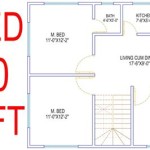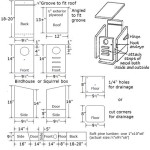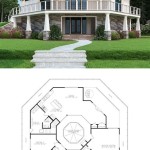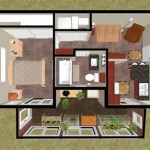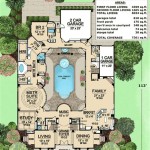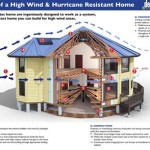A house floor plan is a detailed drawing or blueprint that shows the layout of a house, including the arrangement of rooms, doors, windows, and other features. Floor plans are essential for planning and building a new home, as they provide a visual representation of the space and help ensure that the house meets the needs of the occupants.
Floor plans can be created using a variety of software programs or by hand, and they typically include measurements and dimensions to scale. In addition to the basic layout, floor plans may also include information about the electrical and plumbing systems, as well as the location of appliances and fixtures.
Floor plans are used by a variety of professionals, including architects, builders, and interior designers. They are also helpful for homeowners who are planning renovations or additions to their homes.
When creating a house floor plan, there are several important points to consider:
- Number of rooms
- Room size and shape
- Location of doors and windows
- Traffic flow
- Natural light
- Furniture placement
- Electrical and plumbing needs
- Building codes
- Budget
- Future needs
By considering all of these factors, you can create a house floor plan that meets your needs and creates a comfortable and functional living space.
Number of rooms
The number of rooms in a house is one of the most important factors to consider when creating a floor plan. The number of rooms will depend on the size of the house, the needs of the occupants, and the budget. A small house may have only a few rooms, such as a living room, kitchen, and bedroom, while a large house may have many rooms, such as a living room, dining room, kitchen, family room, bedrooms, bathrooms, and a study.
- One-bedroom house: A one-bedroom house is ideal for a single person or a couple. It typically has one bedroom, one bathroom, a living room, and a kitchen.
- Two-bedroom house: A two-bedroom house is a good option for a small family or a couple who wants a spare room for guests or a home office. It typically has two bedrooms, one or two bathrooms, a living room, and a kitchen.
- Three-bedroom house: A three-bedroom house is a popular choice for families with children. It typically has three bedrooms, two or three bathrooms, a living room, a dining room, and a kitchen.
- Four-bedroom house: A four-bedroom house is a good option for larger families or families who want extra space for guests or a home office. It typically has four bedrooms, three or four bathrooms, a living room, a dining room, and a kitchen.
When choosing the number of rooms for your house, it is important to consider your current and future needs. If you are planning to have children, you may want to choose a house with more bedrooms. If you work from home, you may want to choose a house with a dedicated home office. It is also important to consider your budget, as the more rooms a house has, the more expensive it will be to build and maintain.
Room size and shape
The size and shape of the rooms in a house are important factors to consider when creating a floor plan. The size of a room will determine how many people can comfortably fit in the room and how much furniture can be placed in the room. The shape of a room will determine how the furniture can be arranged and how the room can be used.
- Small rooms are often used for bedrooms, bathrooms, and home offices. Small rooms can be cozy and intimate, but they can also feel cramped if they are not properly furnished and decorated.
Large rooms are often used for living rooms, dining rooms, and kitchens. Large rooms can be more spacious and comfortable, but they can also feel overwhelming if they are not properly furnished and decorated.
- Square rooms are the most versatile and easiest to furnish. Square rooms can be used for any type of room, and they can be easily divided into smaller spaces using furniture or screens.
Rectangular rooms are also relatively easy to furnish, but they can be more challenging to divide into smaller spaces. Rectangular rooms are often used for living rooms, dining rooms, and bedrooms.
- L-shaped rooms can be more difficult to furnish, but they can also be more interesting and unique. L-shaped rooms are often used for living rooms, dining rooms, and kitchens.
U-shaped rooms are even more difficult to furnish, but they can be very spacious and comfortable. U-shaped rooms are often used for kitchens and living rooms.
- Circular rooms are the most difficult to furnish, but they can also be the most visually appealing. Circular rooms are often used for dining rooms, living rooms, and bedrooms.
When choosing the size and shape of the rooms in your house, it is important to consider your needs and lifestyle. If you like to entertain guests, you may want to choose a house with a large living room and dining room. If you work from home, you may want to choose a house with a dedicated home office. It is also important to consider the size of your furniture and how you want to use the space. By carefully considering all of these factors, you can create a house floor plan that meets your needs and creates a comfortable and functional living space.
Location of doors and windows
The location of doors and windows in a house is an important factor to consider when creating a floor plan. The location of doors and windows will affect the flow of traffic through the house, the amount of natural light in the house, and the privacy of the occupants.
Doors should be placed in locations that allow for easy access to all areas of the house. The front door should be located in a prominent location that is easy to find. Other doors should be placed in locations that minimize traffic flow through high-traffic areas, such as the kitchen and living room. Doors should also be placed in locations that provide privacy for the occupants, such as in bedrooms and bathrooms.
Windows should be placed in locations that allow for natural light to enter the house. Windows should also be placed in locations that provide views of the outdoors. However, windows should not be placed in locations where they will compromise the privacy of the occupants. Windows should also be placed in locations that minimize heat loss in the winter and heat gain in the summer.
When choosing the location of doors and windows, it is important to consider the following factors:
- Traffic flow: Doors should be placed in locations that minimize traffic flow through high-traffic areas.
- Privacy: Doors and windows should be placed in locations that provide privacy for the occupants.
- Natural light: Windows should be placed in locations that allow for natural light to enter the house.
- Views: Windows should be placed in locations that provide views of the outdoors.
- Heat loss and heat gain: Windows should be placed in locations that minimize heat loss in the winter and heat gain in the summer.
By carefully considering all of these factors, you can create a house floor plan that meets your needs and creates a comfortable and functional living space.
Traffic flow
Traffic flow is an important factor to consider when creating a house floor plan. The goal is to create a floor plan that allows for easy and efficient movement of people and objects throughout the house. Here are some key points to keep in mind:
- Minimize traffic through high-traffic areas. The kitchen, living room, and hallways are typically the most heavily trafficked areas of a house. When placing doors and furniture, try to avoid creating a situation where people have to walk through these areas to get from one room to another.
- Create a clear path from the front door to the main living areas. Guests should be able to easily find their way from the front door to the living room, dining room, and kitchen. Avoid placing obstacles, such as furniture or large plants, in the way.
- Provide multiple access points to each room. If possible, avoid creating rooms that can only be accessed from one doorway. This will help to reduce traffic congestion and make it easier to move around the house.
- Consider the flow of traffic when placing furniture. Furniture should be placed in a way that does not block traffic flow or create bottlenecks.
By following these tips, you can create a house floor plan that promotes easy and efficient traffic flow.
Natural light
Natural light is an important factor to consider when creating a house floor plan. Natural light can help to reduce energy costs, improve mood, and boost productivity. Here are some key points to keep in mind when planning for natural light in your home:
- Maximize the use of windows. Windows are the primary source of natural light in a home. When placing windows, consider the following factors:
- The size and shape of the windows
- The orientation of the windows
- The placement of the windows in relation to other objects, such as trees and buildings
- Use skylights to bring light into interior spaces. Skylights are a great way to bring natural light into interior spaces, such as hallways, bathrooms, and closets. Skylights can also be used to supplement the natural light provided by windows.
- Consider the use of light-colored materials. Light-colored materials, such as white paint and light-colored flooring, can help to reflect natural light and make a space feel brighter.
- Avoid placing furniture and other objects in front of windows. Furniture and other objects can block natural light from entering a space. When placing furniture, try to avoid blocking windows or placing objects directly in front of windows.
By following these tips, you can create a house floor plan that maximizes the use of natural light and creates a and welcoming space.
Furniture placement
Furniture placement is an important part of creating a functional and stylish home. When placing furniture, there are several factors to consider, including the size of the room, the shape of the room, the traffic flow, and the natural light. Here are some key points to keep in mind when placing furniture:
Consider the size of the room. The size of the room will determine how much furniture you can fit in the space. A small room can be easily overwhelmed by too much furniture, while a large room can feel empty if there is not enough furniture. When selecting furniture, choose pieces that are appropriately sized for the space. Avoid overcrowding the room, but also avoid leaving too much empty space.
Consider the shape of the room. The shape of the room will also affect how you place furniture. A square room is the easiest to furnish, as you can simply place furniture against the walls. A rectangular room can be more challenging to furnish, but you can use furniture to create different zones within the space. For example, you could use a sofa to create a seating area in one corner of the room and a desk to create a work area in another corner.
Consider the traffic flow. When placing furniture, it is important to consider the flow of traffic through the room. Avoid placing furniture in the middle of the room or in front of doorways. This will help to keep the room feeling spacious and open.
Consider the natural light. When placing furniture, consider the natural light in the room. Place furniture in a way that takes advantage of the natural light. For example, you could place a sofa near a window so that you can enjoy the view while you relax.
Electrical and plumbing needs
When creating a house floor plan, it is important to consider the electrical and plumbing needs of the home. This includes planning for the location of outlets, switches, light fixtures, and plumbing fixtures. Here are some key points to keep in mind:
- Electrical outlets should be placed in all rooms, including the kitchen, living room, bedrooms, and bathrooms. Outlets should be placed near furniture and appliances, and they should be spaced evenly throughout the room. You should also consider the placement of outdoor outlets for things like holiday lights and power tools.
- Light switches should be placed at all entrances to a room, as well as near the bed in bedrooms. Light switches should also be placed near furniture and appliances that require lighting. You should also consider the placement of dimmer switches to control the amount of light in a room.
- Plumbing fixtures, such as sinks, toilets, and showers, should be placed in convenient locations. The kitchen sink should be located near the stove and refrigerator. The bathroom sink should be located near the toilet and shower. You should also consider the placement of a half-bath on the first floor of the home for guests and convenience.
By carefully considering the electrical and plumbing needs of the home, you can create a house floor plan that is both functional and comfortable.
Building codes
Building codes are regulations that govern the construction of buildings. These codes are in place to ensure that buildings are safe and habitable. Building codes cover a wide range of topics, including structural requirements, fire safety, and energy efficiency. Here are some key points to keep in mind when creating a house floor plan that complies with building codes:
- Structural requirements: Building codes specify the minimum requirements for the structural integrity of a building. These requirements include the size and spacing of framing members, the type of foundation, and the wind and snow loads that the building must be able to withstand. When creating a house floor plan, it is important to make sure that the plan complies with the structural requirements for your area.
- Fire safety: Building codes also include requirements for fire safety. These requirements include the installation of smoke detectors and fire sprinklers, the use of fire-resistant materials, and the provision of safe egress from the building. When creating a house floor plan, it is important to make sure that the plan complies with the fire safety requirements for your area.
- Energy efficiency: Building codes often include requirements for energy efficiency. These requirements may include the use of energy-efficient appliances and lighting, the installation of insulation, and the use of renewable energy sources. When creating a house floor plan, it is important to consider the energy efficiency requirements for your area and to design a plan that meets or exceeds these requirements.
- Accessibility: Building codes may also include requirements for accessibility. These requirements ensure that buildings are accessible to people with disabilities. When creating a house floor plan, it is important to consider the accessibility requirements for your area and to design a plan that meets or exceeds these requirements.
By following the building codes for your area, you can create a house floor plan that is safe, habitable, and energy-efficient.
Budget
The budget is one of the most important factors to consider when creating a house floor plan. The budget will determine the size of the house, the materials used, and the level of detail in the floor plan. Here are some key points to keep in mind when budgeting for a house floor plan:
- Size of the house: The size of the house is the biggest factor that will affect the cost of the floor plan. A larger house will require more materials and labor to build, and will therefore cost more to design.
- Materials used: The materials used in the construction of the house will also affect the cost of the floor plan. Higher-quality materials, such as hardwood floors and granite countertops, will cost more than lower-quality materials, such as laminate flooring and tile countertops.
- Level of detail: The level of detail in the floor plan will also affect the cost. A more detailed floor plan will take more time to create, and will therefore cost more.
- Complexity of the design: The complexity of the design will also affect the cost. A more complex design will require more work to create, and will therefore cost more.
It is important to work with your architect or builder to create a budget that meets your needs and expectations, and create a house floor plan that is both affordable and functional.
Future needs
In addition to your current needs, it is also important to consider your future needs when creating a house floor plan. This includes planning for changes in your family size, your lifestyle, and your age. Here are some key points to keep in mind:
- Changes in family size: If you are planning to have children or if you have children who will eventually be moving out, you will need to consider how these changes will affect your space needs. For example, you may need to add bedrooms or bathrooms, or you may need to create a more open floor plan to accommodate a growing family.
- Changes in lifestyle: As you get older, your lifestyle may change. You may decide to retire and spend more time at home, or you may start a new hobby that requires more space. When creating a house floor plan, consider how your lifestyle may change in the future and make sure that the plan can accommodate these changes.
- Changes in age: As you age, you may need to make changes to your home to make it more accessible and safe. For example, you may need to add grab bars in the bathroom or install a ramp in the garage. When creating a house floor plan, consider how your needs may change as you age and make sure that the plan can accommodate these changes.
- Technology: As technology advances, your needs for your home may also change. For example, you may want to add a home office or a media room. When creating a house floor plan, consider how you may use technology in the future and make sure that the plan can accommodate these changes.
By considering your future needs, you can create a house floor plan that will meet your needs for many years to come.










Related Posts

